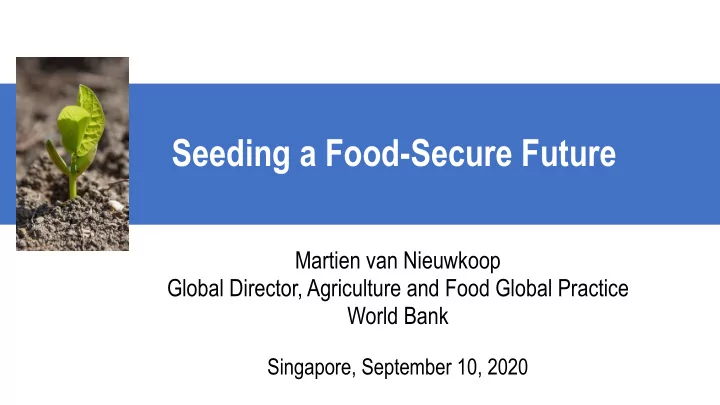

Seeding a Food-Secure Future Martien van Nieuwkoop Global Director, Agriculture and Food Global Practice World Bank Singapore, September 10, 2020
Global hunger & acute food insecurity are projected to rise in 2020 Millions of people 2019 End 2020 Projection +20% +96% 828 688 265 135 Hunger [FAO] Acute Food Insecure [WFP] FAO = Food and Agriculture Organization WFP = World Food Program 2
Local food prices have increased and at a faster rate than overall inflation Average Food Inflation Relative to Overall Consumer Price Index (CPI) - All Countries (% change, year-on-year) 6.8% 5.8% 5.5% 4.7% 4.9% 5.8% 5.7% 4.1% 4.0% 4.4% 3.6% 4.2% 3.8% 2.7% 3.6% Food and Beverage Component of CPI 2.2% Overall CPI October November December January February March April May 2019 2020 3
COVID-19 is impacting food security through multiple pathways Higher food imports costs with Reduced Disruptions to currency depreciations incomes supply chains Weather extremes and the locust outbreak are exacerbating impacts Food Insecurity 4
Food system weaknesses have amplified impacts Inflexible supply Inadequate food Obesity Malnutrition chains safety Animal-to-human Increased severity Food loss Weakened immune disease transmission of impact & waste systems 5
Broader challenges remain How do we feed … while lowering … while improving climate resilience 10 billion (mainly emissions and reducing water stress urban) people… …and lifting the extreme poor who work in the food system out of poverty? 6
10 Critical (Multi-sectoral) Transitions Needed to Transform Food Systems Healthy People Healthy Planet Healthy Economy 7
There are 4.4bn people to feed in cities today. 2.3bn more by 2050 The world’s urban population is projected to increase by more than 50% over the next 30 years 10 9 8 7 Billion people 6 5 4 3 2 1 0 1950 1955 1960 1965 1970 1975 1980 1985 1990 1995 2000 2005 2010 2015 2020 2025 2030 2035 2040 2045 2050 Rural population Urban population 8
Urban Asia’s challenges and opportunities Challenges Opportunities • Growing middle class • 535m in urban slums with complex food issues • Rapid dietary/eating pattern change • 1/4 of urban Asia is food insecure • higher value foods • out-of-home eating • Large loss of farmland due to urban conversion • Wide scope for food business innovation • Other hotspots • food service • foodborne illness • e-commerce • diet-related non-communicable diseases • bio-economy • food plastics and other waste • Food culture as an attraction for domestic and international tourism • Hybrid systems - small ‘modern’, large informal 9
Are cities in Asia ready? RICH food systems • R eliable • I nclusive • C ompetitive • H ealthy 10
Some cities are more engaged on urban food systems than others Share of 170 Sampled Cities in 21 countries in Asia 8% Food Smart Progressive 19% 44% Food Engaged Reactive 19% 11
12
1. Urban food system governance Stakeholder engagement To address urban food issues To improve food Integration in plans Examples : system outcomes… Logistics (to manage food Laws inflows to cities) Healthy city people Responsibility Food safety Healthy city economy Healthy city environment Modes of intervention Urban agriculture Resources …with due consideration School food equality to other outcomes that Performance tracking also matter to cities Food waste 13
2. Urban food consumption Influence food choice Safety nets E.g. E.g. Consumer education School food equality Pricing/food taxation Institutional procurement Food banks Manage food waste Soup kitchens 14
3. Food logistics and marketing e.g. Informal food sector • Engage with informal sector actors • Improve transportation to designated informal markets • Invest in food market upgrades • Progressively hold informal sector players to higher standards • Develop clear and consistent policies and guidelines 15
4. Urban (and peri-urban) food production e.g. Agricultural land protection in the city vicinity • Planning activities that curb pressure for urban expansion on farmland • Compact urban design Land-use restrictions that protect farmland (e.g. urban boundaries, greenbelts, • agricultural zones) • Fiscal measures to curb market pressure to sell farmland • Farm and food economy support measures that increase the value of farming 16
Call to Action City leaders & policy makers CSOs, City planning research & educational professionals organizations RICH Urban Food Systems International National development technical partners ministries Food companies & industry associations 17
World Bank support for agriculture and food • Support through national (and state) government • Financial and technical assistance Healthy Longer-term focus on: • economy - Increasingly deliver on multiple objectives at the same time. o Healthy people o Healthy economy Healthy Healthy o Healthy planet planet people - Helping repurpose public support - Crowding-in private sector finance 18
Recommend
More recommend